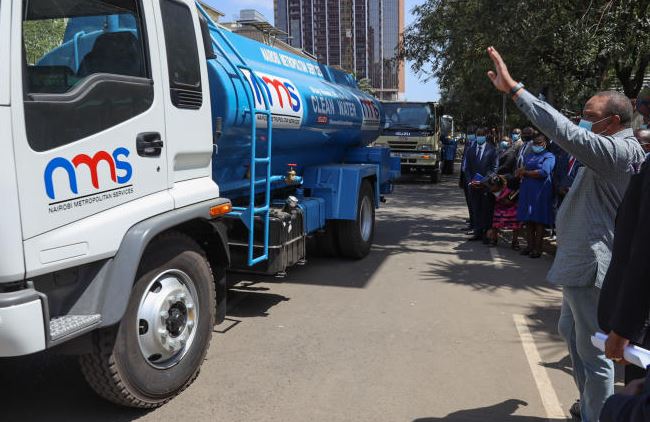
FILE PHOTO: President Uhuru flagging off NMS branded Water Trucks (PHOTO: PSCU)
Residents of Nairobi County will soon escape the choking grip of city water cartels who have for years interfered with the consistent supply of water leading to price hikes.
This is after Major General Mohammed Badi announced that the Nairobi Metropolitan Services (NMS) in collaboration with the Ministry of water was developing an app similar to the taxi-hailing app Uber or Little cab in which customers will be shown all registered water bowsers and choose which one to buy from.
Once a user has downloaded it on their phone or device and turned on the location service, the app will be able to show the number of bowsers in the resident’s area and the individual information of each of the water bowsers.
Moreover, the app will indicate how much one is supposed to pay depending on the need of the buyer.
"Once you decide what you need in your area, the app will show you the water bowsers in the area, where they collect water to ensure safety and the amount they have paid for that water,” said Badi who was speaking during an interview with Spice FM.
READ MORE
Governor Sakaja in a spot over Sh2.2 billion variances in revenue collection
Otters, Hydra Aquatics clubs win NCSA gala
Unanswered questions on management, transparency of Sakaja's Dishi na County
The Director-General explained that the Ministry of water was at an advanced stage with the development of the app given that it had concluded the registration of all water bowsers and exhaust trucks in the capital.
He also brought to the fore that the decision to develop the app was informed by the incessant complaints from Nairobi residents who have had to grapple with an acute water shortage and who have been operating at the mercy of unscrupulous water suppliers.
Badi explained that water bowser operators fetch water for free from unspecified water sources or corrupt the county supply lines to direct the water their way, which they later load onto their bowsers and sell to the unsuspecting members of the public.
This is also evidenced by a report by the Auditor General on the financial statements of Nairobi City Water and Sewerage Company (NCWSC) ltd, which states that NCWSC continues to suffer losses running to Sh1 billion annually due to non-revenue water (unaccounted for water) occasioned by water leakages, illegal connections, and a faulty billing system.
The Director-General further stated that the net effect of the cartel infiltration into the water business was not only raising the cost of water but also pre-exposes residents to health conditions given that the areas that the bowsers draw their water might be contaminated.
“Nobody knows the number (of water browsers) that are in the city. We demanded that they get registered or lose licenses. Within that registration process, it was a must for you to indicate the place where you draw your water and the areas which you supply,” he said.
"Before, they used to take city water free of charge and sell it to citizens. The Ministry of water now is developing an app where you will be able to order for these water bowsers just like Uber," added Badi.
The development of the app is the latest measure in a series of many that have been implemented by NMS and NCWSC in a bid to reform the lucrative but cartel-ridden water business in the city.
In June 2020, NCWSC introduced stringent measures to streamline the operations of water bowsers and exhaust trucks in the capital.
They included that water bowsers in Nairobi have to undergo inspection before commencing operation while exhausters also all have to be repainted brown and inspected before being allowed to operate in the capital.
In the new measures, owners of water bowsers are required to provide a quality certificate of their source of water from a government certified laboratory.
They should also ensure the water bowser tank is painted sky blue and that the interior is lined with food bitumen.
They should be fitted with a water sampling point and the tanker volume indicated besides a graduated level indicator on the side. Water bowsers or tankers are required to have a 600mm circular lockable inspection chamber and the tanker’s body devoid of rust.
The owner’s name and telephone number are to be marked with 75mm letters on each side of the tanker. The tankers shall be labelled with the name water tank on the sides of the tank.
All exhausters should, going forward, present clearance certificates from the National Environment Management Authority (NEMA) and pay annual discharge fees before the sub-licence can be issued.
They should also always display in the truck the original letters of approval to discharge into approved points, payment receipt for discharge licence and the business permit issued by Nairobi Metropolitan Services.
The volume is also to be indicated on the body of the exhauster and they should also be fitted with a sealed tank and accessories that are leak proof to liquid and gases. Exhausters will further need to be fitted with sludge pumps.
The capacity of the exhauster will have to be indicated on the sides and the rear with the letters being at least 75mm in size. The word “exhauster” should be written on all sides and the rear of the tank.
“NCWSC reserves the right to cancel the permit to discharge into its sewerage system or impose requisite fees in the event that you fail to comply with the laid down conditions,” said the NCWSC Managing Director Nahashon Muguna.

